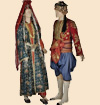 Turkey is a country with old clothing traditions. Their roots are in the Ottoman Empire which has formed Turkish cultural and traditional heritage pretty much. Even hundreds of years after the Ottoman Empire, Turkish national costume has a lot of features typical for those days. But today few people in Turkey wear traditional clothing in day-to-day life. Men usually use European style of clothes or mix some elements of the folk dress with western pieces of attire. Women wear national costumes more often, they retained the national dress more fully and keep the traditions more carefully.
Turkey is a country with old clothing traditions. Their roots are in the Ottoman Empire which has formed Turkish cultural and traditional heritage pretty much. Even hundreds of years after the Ottoman Empire, Turkish national costume has a lot of features typical for those days. But today few people in Turkey wear traditional clothing in day-to-day life. Men usually use European style of clothes or mix some elements of the folk dress with western pieces of attire. Women wear national costumes more often, they retained the national dress more fully and keep the traditions more carefully.
Turkish national dress dramatically changed in XX century. There used to be garments typical to Islamic custom: women wore abaya dresses and men wore turbans and fezzes. In 1925 such clothing was announced illegal by the government of Turkey. After that people began to wear more European style of clothing. Although, women still use a lot of pieces of traditional Turkish costume, but men usually wear a mix of modern and vintage parts of attire. For example, men use caps instead of turbans.
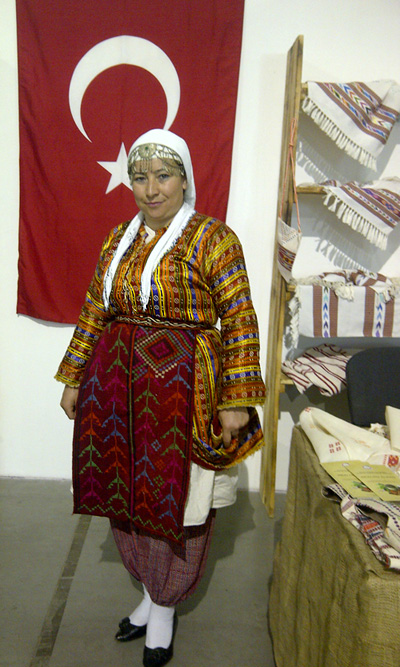
Turkish woman in national costume
One of the typical features of Turkish clothing is the usage of many layers. Very often people wear trousers, a long robe and a jacket on top. Women usually wear several scarves or kerchiefs of different colors. Flamboyance is another typical thing for Turkey. The traditional attire is always colorful, bright and striking.

Turkish woman in national clothing presents Turkish embroidered towels
One of the most amazing pieces of Turkish clothing is socks. They are handmade and very bright. A lot of different patterns are used. The yarn used for knitting is colorful, natural and warm.
There are 7 geographical regions of Turkey: Aegean, Black Sea, Central Anatolia, Eastern Anatolia, Marmara, Mediterranean and Southeastern Anatolia. Each one of them has its own clothing traditions and features of national costume. Traditional attire of various regions differs one from another much. So, let's talk about traditional clothing of each region separately.
Traditional dress of Aegean region
Women's attire consists of a long robe, baggy trousers, a short jacket, an apron, several head scarves (sometimes with a fez), slippers, and a lot of jewelry. Traditional fabrics are silk, velvet, and cotton. Every piece of clothing is embroidered or embellished. Different patterns of fabric are popular, but the most common are colorful stripes.
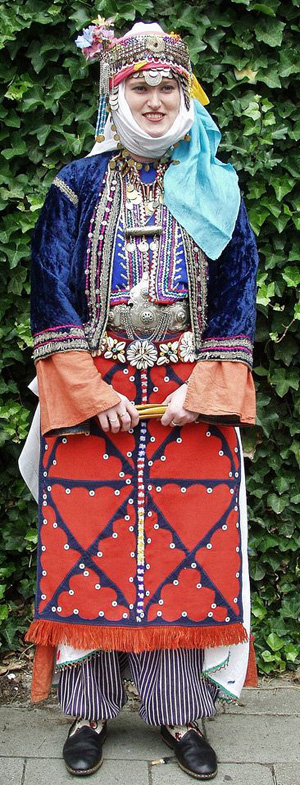
Traditional festive costume from Merkez Kapıkaya köyü, Aegean region. Photo from Pinterest.com, by Jean-Marie Criel
Men's attire consists of short baggy trousers, a jacket, a shirt, a wide belt, a neckerchief, a headgear, socks, and slippers or boots. Male clothing is also rather bright and colorful, embroidered and decorated with jewelry. Stripes are the most popular among patterns on fabric. The headdress can be very interesting, high and unusual (not only fez or turban).

Traditional wedding costumes from the Aydin province, Aegean region. Photo from Pinterest.com, by Jean-Marie Criel
Traditional dress of Black Sea region
People who live in this region are very strict, proud-spirited and independent. And their costumes are made in the same spirit. Traditional clothing is used mostly by women, while men wear western-style garments.
Women's attire consists of a peştemal (it is a piece of linen, usually striped, wrapped around the waist), a shawl called "keşan" (which covers the head, torso, and face), socks and shoes or slippers. In some parts of Black Sea region women also use blue aprons, in other female costume consists of a dress made of black silk brocade and a bright orange waistcloth. But still, peştemal and keşan are considered to be the national clothing of Black Sea region of Turkey. Typical colors of garments of this region are black, orange, burgundy, crimson and brown. Stripes are often used, just as in other Turkish regions.
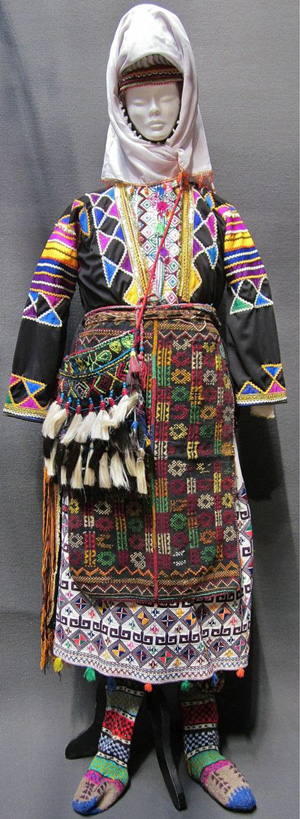
Traditional daily costume from Nebiköy, Black Sea region. Photo from Pinterest.com, by Jean-Marie Criel
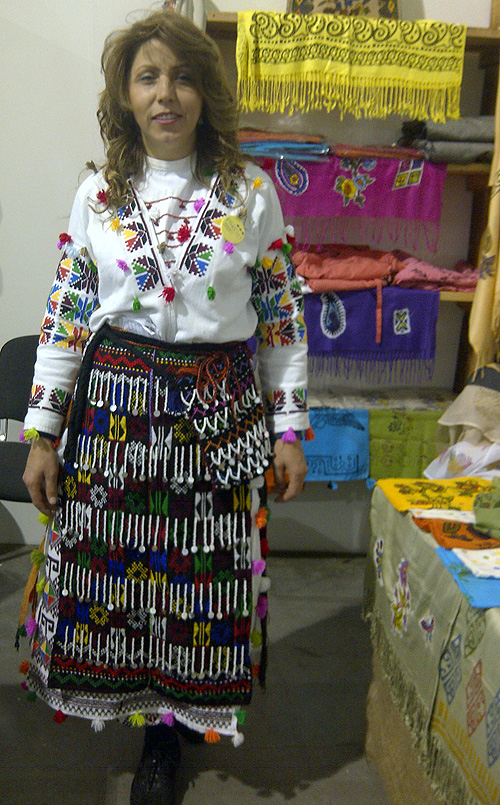
Turkish woman from Pontic region in traditional clothing (without a headdress)
Men's attire consists of baggy trousers (called "şalvar" or "shalwar kameez"), a shirt, a jacket (it often was a yelek – Ottoman male jacket with hanging sleeves), a headdress, socks, and shoes or boots.
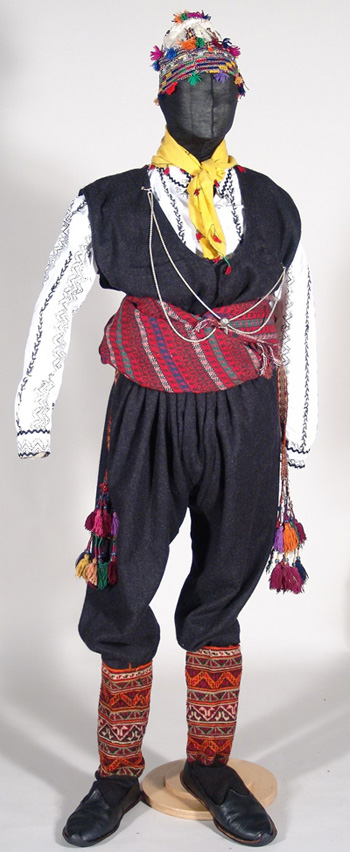
Traditional bridegroom/festive costume from Nebiköy, Black Sea region. Photo from Pinterest.com, by Jean-Marie Criel
Traditional dress of Central Anatolia
Women's attire consists of baggy trousers, a skirt, an apron, a shirt, a jacket, a belt (often it is a piece of colorful cloth), a headdress, socks, and shoes. Central Anatolian dress is very rich, colorful and embellished. There is lots of jewelry used with festive costumes. Pieces of clothing are hand-woven and richly embroidered. Silk, velvet, cotton and woolen cloth are popular.

Traditional costume of a village bride from the central district of the Sivas province, Central Anatolia. Photo from Pinterest.com, by Jean-Marie Criel
Men's attire consists of long or short baggy trousers, a shirt, a yelek (Ottoman male jacket with hanging sleeves) or another jacket, a wide belt, headgear, socks, and boots or shoes. The most used colors are blue, red, yellow and black. The striped fabric is also used sometimes. The male costume has less embellishment (including embroidery) than female one. But every festive Turkish costume should be equipped with a weapon (pistols, guns, swords, knives etc.). Central Anatolian men's garment is no exception.

Traditional parade costume of the people's militia from Dinar, Central Anatolia. Photo from Pinterest.com, by Jean-Marie Criel
Traditional dress of Eastern Anatolia
Eastern Anatolia is a region where many Kurdish and Armenian people live together with Turkish people. That's why the national costume of this territory has a lot of features of Kurdish and Armenian clothes.
Women's attire consists of baggy trousers, a long skirt, robe or dress, a shirt, a jacket, a wide belt (or piece of cloth as a belt), a scarf or other headdress, socks and shoes or slippers. As well as in other regions of Turkey, in Eastern Anatolia women wear many layers of clothes. The whole body is covered with clothing (as Turkey is a Muslim country). Garments are bright and colorful, the red color is one of the most popular. Fabrics with floral patterns are widespread. Women don't use lots of jewelry. The clothing is often pretty simple but can look rather festive even without much jewelry.
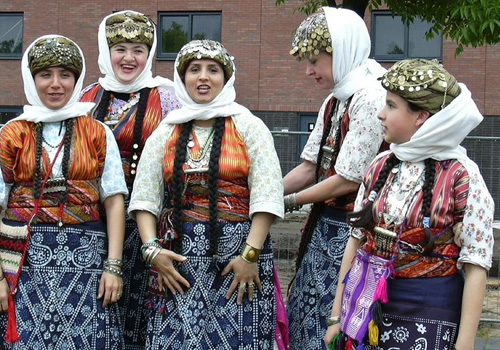
Traditional festive village costumes from Adiyaman and Malatya, Eastern Anatolia. Photo from Pinterest.com, by Jean-Marie Criel
Men's attire consists of baggy trousers, a shirt, a jacket (today it is sometimes replaced by a vest), a wide belt, a headgear, socks, and shoes or boots. Kurdish costume usually consists of a long robe, a shirt or undershirt, a wide belt, a headscarf, socks and shoes. Men's modern costume often looks pretty European-style; only şalvar trousers give some Turkish flavor to the garment.
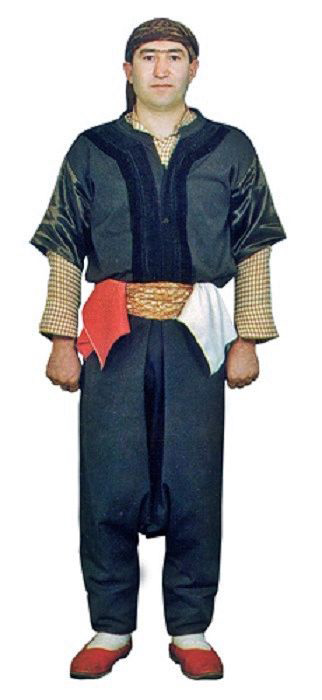
Traditional costume from the province of Urfa, South-Eastern Anatolia. Photo from Pinterest.com, by Jean-Marie Criel
Traditional dress of Marmara region
The national clothing of Marmara region of Turkey differs a little bit from garments used in other regions. People in Marmara region mostly use a lot of embroidery on their costumes. They always embroider undergarments (underpants and undershirt) because they are seen from under the upper clothing. Embroidery on attire is the main embellishment of traditional clothing of this area.
Women's attire consists of very wide baggy trousers, a long-sleeved vest, a jacket, a belt, a headgear, socks, and shoes. Sometimes an apron is also used. Another variant of folk dress consists of embroidered underpants and long undershirt, a skirt, a jacket, a kerchief on the waist, a belt, a headdress, socks, and shoes. Clothes look multilayer, puffy and rather checkered because of rich embroidery.
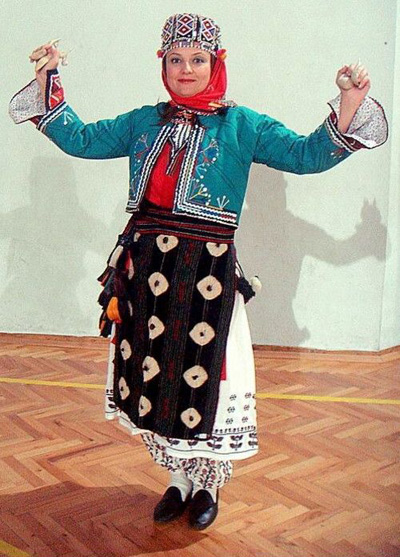
Traditional festive costume for girls and young women, from the Türkmen villages in the Keles district, Marmara region. Photo from Pinterest.com, by Jean-Marie Criel
Men's attire consists of rather narrow baggy trousers (tucked into socks), a shirt, a vest, a hand towel, worn on the waist belt, another towel, worn across the shoulders, a headdress, high socks and shoes. Very often neckerchief is used as well. Male costume, same as female, is richly embroidered and embellished. It is also bright, puffy and multilayer. The shirt is usually striped. A bag, weapons, and a tobacco purse complement the image.
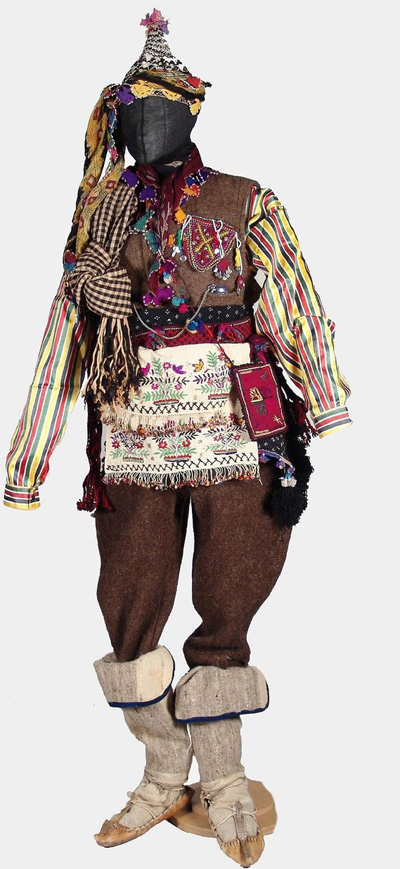
Traditional bridegroom/festive costume of the Karakeçeli villages in the district of Keles, Marmara region. Photo from Pinterest.com, by Jean-Marie Criel
Traditional dress of Mediterranean region
Women's attire consists of a skirt or dress (below the knee long), a shirt, a jacket, a headdress or kerchief, socks, and shoes. The costume is very bright and colorful. The most common colors are red, blue and yellow. The striped cloth is often used for dresses, skirts, and shirts. The clothing looks rich, embellished and multilayer.
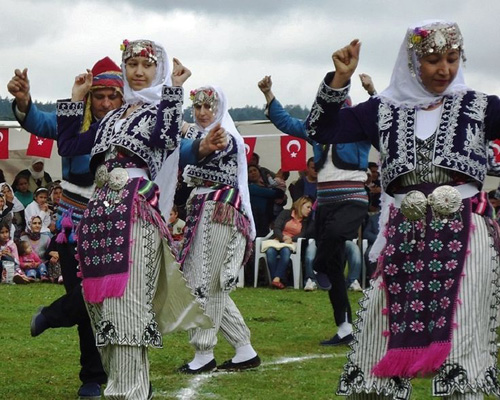
Traditional festive costumes of the Honamli Yörükleri (Toros Mountains, Antalya province, Mediterranean region). Photo from Pinterest.com, by Jean-Marie Criel
Men's attire consists of baggy trousers (tucked into socks), a shirt, a jacket, a wide belt, a headgear, high socks and shoes. Male traditional costume looks rather simple but festive. It's a strict beauty. The color of trousers and jackets is dark: black, brown or blue. But jackets are embellished with embroidery. The belts are colorful and fall into the eye.
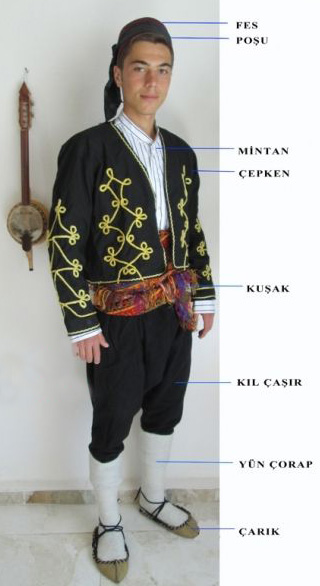
Traditional festive costume from Tefenni (in the province of Burdur, Mediterranean region). Photo from Pinterest.com, by Jean-Marie Criel
Traditional dress of Southeastern Anatolia
Women's attire consists of a long dress, a caftan (a long robe), a belt, a headscarf or other headdress, socks and shoes. Folk dress of this region is rather laconic, it has only few layers. It looks very feminine and tender. But still, the whole body should be covered with clothes. The pieces of attire are embellished with embroidery and jewelry, but moderately, not as richly as in some other regions.

Traditional festive village costume from the Gaziantep province, Southeastern Anatolia. Photo from Pinterest.com, by Jean-Marie Criel
Men's attire consists of baggy trousers, a shirt, a robe (knee-long or just above the knee) or a jacket, a wide belt or kerchief around the waist, a headdress, socks, and shoes or boots. The clothing looks pretty simple, without much embellishment. The outerwear (caftan, jacket, vest or robe) is usually embroidered.
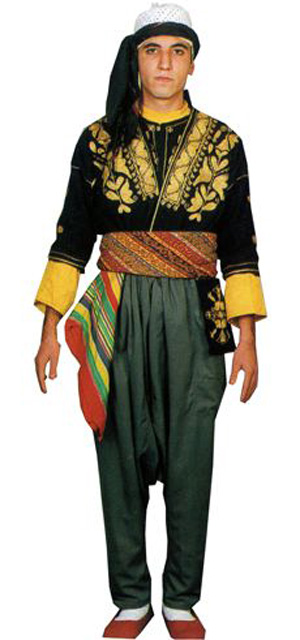
Traditional costume of the people's militia, from Gaziantep (Southeastern Anatolia region). Photo from Pinterest.com, by Jean-Marie Criel
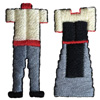


But with Gulf countries? We have none. They speak Arabic, are Semites or Arabs, and have their own separate religion-based culture. We speak Turkish, are Turks and have our own Turkic culture. I'd get it if Turkey were grouped with Iran among the so-called Middle Eastern countries, but it's ridiculous for it to be in the same group as the people of the Gulf. They look nothing like Turks, don't act like Turks, and don't like Turks.
You're making no sense. Syrians are Arabs, and Turks are Turks; these people don't have anything in common ethnically. Also, Syrians speak Arabic and Turks speak Turkish, which belong to different language families. Turkey is not entirely Middle Eastern, as Anatolia as a whole is not considered to be a part of the Middle East. Search "Asia Minor" or "Armenian Highlands" on Google; the parts that are not colored are in the Middle East, but the rest are not. Also, Turkey is literally in the middle of the world, so classifying it in just one category is just nonsense. Almost 25% of Turkey's population consists of Balkan Turks, including myself, and we have nothing in common with Syrians or the Middle East. People from the Black Sea or the Aegean and Mediterranean coasts would openly laugh at your face for considering their region to be a part of the Middle East. Similar cultures? Music? Dance traditions? You have to be kidding me. The only thing Turkey shares with Syria is a few dishes left over from the Ottoman Empire, and that's it. Our traditional dances are nothing like yours. When it comes to music, there is one genre that is literally called "Arabesque," and that's the only similar thing we have with you. It's not surprising for it to be similar to your music because it's literally called "Arab style music". Your ignorance shows in your claims about Turks and Syrians being the same people when these people didn't even originate in the same place. No Turk is an Arab, and no Arab is a Turk. Turks of Anatolia are MOST similar to Turks from Azerbaijan. Simple as that.
are you aware how do you embarrass yourself by saying Turkey, a bridge between Asia and Europe is not considered European while Armenia, Azerbaijan and Georgia which don't have even 0.1% of their territories on the European continent are European...?
us?? who tf said you could consider yourself a Turk? dont say us
thus from now I am using net for content, thanks to web.
Turks are NOT native to Anatolia. They came from Mongolia from the East. Anatolian indigenous people are Greeks, Kurds, Armenians, Assyrians, and Persians. You can find their history dating back before the Ottoman empire was even created.
Thanks). Corrected
yes , but still as one people tho .. but some cultural differences are there yes ..
its own clothing traditions аnd features
There is so much wrong in this, check your facts.
They are some of the TURKISH folk clothing but not all of them, and to your comment is not to be taken seriously because of course there would be little similarities between folks living in same territory thousands of years. That`s just funny you spread your negative energy like that :)
When you combine these cultures, Anatolian culture occurs.
By the way, Georgia and Azerbaijan are ABOVE Armenia, which would make Armenia completely in Asia/Middle East/whatever you want to call the region (which it is)... and Armenian culture can definitely be classified as Middle Eastern. So can Turkey’s. Sorry to change the topic, but I just felt this needed to be pointed out,
Yea it is!! Then what is it? African?
I am Turkish from Istanbul and I know my country/region...lol!!
That is why it is called the Middle East lol!!! It is the region between Asia, Africa and Europe. Learn your definitions!!
Quoting Esra:
Quoting Leyla:
Turkey is middle eastern. Idk why Turks get so offended by this. Not only geographically, but culturally we have so much in common with middle eastern countries it shouldn't be taken as an insult.
As for Armenia and Azerbaijan, it's not a competition. Why is it such an important thing to be considered European? Geographically Europe extends up north down to Armenia, and parts of Georgia and Azerbaijan, hence the classification.
I'm a proud Turk and I love the diversity our country has and I think we should acknowledge and accept the fact that our roots come from the east.
None of those ethnicities are Native Anatolians. Turks are Native Anatolians,
Cultural reasons? You believe Armenia is Europe but Turkey is Middle Eastern? Turkey isn't culturally Middle Eastern. I'd say Turkey under Asia or Europe since it is an Eurasian country, but not Middle East.
Where would you take it? To what part of the world?
We added it to the Middle East, but not by geographic position, rather by cultural peculiarities.
What a troll. According to Armen, Turks must be aliens.